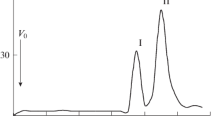Summary
Lipopolysaccharides are integral components of the outer membrane of Gram-negative bacteria and they participate in various membrane functions essential for bacterial growth and survival. Lipopolysaccharides also represent the endotoxins of Gram-negative bacteria and possibly play a role for the pathogenesis and manifestations of bacterial infections. These biological activities are mediated mainly by the lipid component of lipopolysaccharides, termed lipid A. Chemically, lipid A consists of a β1,6-linkedD-glucosamine disaccharide which carries substituted phosphoryl groups and a range ofD-3-hydroxy andD-3-acyloxyacyl residues, the latter being arranged in a hexagonal dense packing.
A number of experimental data allow the conclusion that the highly ordered and compact lipid A structure confers stability to the outer membrane, renders it less permeable to lipophilic molecules and by providing a proper fluidity stabilizes the conformation of biologically active membrane proteins. For endotoxic activities of lipid A the polar substituents of phosphate residues are dispensable. The presence ofD-3-hydroxy (or acyloxy) acyl-groups, linked to the glucosamine disaccharide, however, seems to be of importance. Analyses of now available synthetic lipid A analogues are expected to allow a more precise characterization of substructures and conformations required for the expression of physiological functions and endotoxic activities of lipid A.
Similar content being viewed by others
References
Nikaido H, Nakae T (1979) The outer membrane of gramnegative bacteria. In: Rose AH, Morris JG (eds) Advances in microbial physiology, Vol 20, Academic Press, London, pp 163–250
Inouye M, ed (1979) Bacterial outer membranes. Wiley and Sons, New York Chichester Brisbane Toronto, pp 1–534
Fischer E, Braun V (1981) Die Penetrationsbarriere der Bakterienzellwand als Ursache der Antibiotikaresistenz. Immun Infekt 9:78–87
Lüderitz O, Freudenberg MA, Galanos C, Lehmann V, Rietschel ETh, Shaw DW (1982) Lipopolysaccharides of gram-negative bacteria. In: Razin CS, Rottem S (eds) Microbial membrane lipids. Vol 17. Academic Press, New York pp 79–151
Braun V, Hantke K (1982) Bacterial cell surface receptors. In: Ghosh BK (ed) Organization of procaryotic cell membranes, vol 2. CRC Press, Bocta Raton, FL (in press)
Rietschel ETh, Schade U, Jensen M, Wollenweber HW, Lüderitz O, Greisman SG (1982) Bacterial endotoxins: Chemical structure, biological activity and role in septicaemia. Scand J Infect Dis (Suppl) 31:8–21
Berry J (1982) Pathogenic mechanisms of infectious diseases, Klin Wochenschr 60:3–5
Liang-Takasaki CJ, Mäkelä PH, Leive L (1982) Phagocytosis of bacteria by macrophages: Changing the carbohydrate of the lipopolysaccharide alters interaction with complement and macrophages. J Immunol (in press)
Nowotny A (1981) Time-dependent changes in the artificially induced host resistance. Klin Wochenschr 60:45–49
Urbaschek RM, Shadduck RK, Bona C, Mergenhagen SE (1980) Colony-stimulating factor in nonspecific resistance and in increased susceptibility to endotoxin. In: Schlessinger D (ed) Microbiology. Am Soc Microbiol, Washington, DC, pp 115–119
Rietschel ETh, Galanos C, Lüderitz O, Westphal O (1982) Chemical structure, physiological function and biological activity of lipopolysaccharides and their lipid A component. In: Webb D (ed) Immunopharmacology and the regulation of leukocyte function, pp 183–229 Marcel Dekker, New York (in press)
Galanos C, Lüderitz O, Rietschel ETh, Westphal O (1977) Newer aspects of the chemistry and biology of bacterial lipopolysaccharides, with special reference to their lipid A component. In: Goodwin TW (ed) International review of biochemistry: Biochemistry of lipids II, vol 14, pp 239–335
Wollenweber H-W, Broady K, Lüderitz O, Rietschel ETh (1982) The chemical structure of lipid A: Demonstration of amide-linked 3-acyloxyacyl-residues inSalmonella minnesota Re lipopolysaccharide. Eur J Biochem 124:191–198
Weckesser J, Drews G, Mayer H (1979) Lipopolysaccharides of photosynthetic prokaryotes. Ann Rev Microbiol 33:215–239
Nowotny A, Nowotny A, Behling UH (1980) The neglected problem of endotoxin heterogeneity. In: Agarwal MK (ed) Bacterial endotoxins and host response. Elsevier, North Holland Biomedical Press, Amsterdam New York Oxford, pp 3–9
Wawra H, Buschmann H, Formanek H, Formanek S (1979) Strukturuntersuchungen mit Röntgenmethoden an Lipopolysacchariden vonSalmonella minnesota Mutanten SSF 1111 und R 595 SF 1167. Z Naturforsch 34c:171–178
Emmerling G, Henning U, Gulik-Krzywicki T (1977) Order-disorder conformational transition of hydrocarbon chains in lipopolysaccharide fromEscherichia coli. Eur J Biochem 78:503–509
Labischinsky H, Giesbrecht P (1981) Personal communication
Ueki T, Mitsui T, Nikaido H (1979) X-ray diffraction studies of outer membranes ofSalmonella typhimurium. J Biochem 85:173–182
Formanek H, Weidner H (1980) Threedimensional structure of the carbohydrate moiety of a lipopolysaccharide. Computer calculations. Z Naturforsch 36c:71–78
Yamada H, Mizushima S (1980) Interaction between major outer membrane protein (0–8) and lipopolysaccharide inEscherichia coli K-12. Eur J Biochem 103:209–218
van Alphen L, Lugtenberg B, Rietschel ETh, Mombers Ch (1979) Architecture of the outer membrane ofEscherichia coli K-12. V. Phase transitions of the bacteriophage K3 receptor complex. Eur J Biochem 101:571–579
Kuusi N, Nurminen M, Saxen H, Mäkelä PH (1981) Immunization with major outer membrane protein (porin) preparations in experimental murine salmonellosis: Effect of lipopolysaccharide. Infect Immun 34:328–332
Wollenweber HW, Schlecht S, Lüderitz O, Rietschel ETh (1982) Demonstration of unsaturated fatty acids in lipopolysaccharides of gram-negative bacteria grown at low temperature. J Bacteriol (in preparation)
Kanegasaki Sh, Tanamoto K, Kohayashi S, Kojima Y, Homma JT, Rietschel ETh (1982) Comparison of antitumor, fever and interferon-inducing activity of lipopolysaccharides obtained from various Gram-negative bacteria. Infect Immun (submitted)
Inage M, Chaki H, Kusumoto Sh, Shiba T, Tai A, Nakahata M, Harada T, Izumi Y (1980) Chemical synthesis of bisdephospholipid A ofSalmonella endotoxin. Chemistry Letters (Japan) 1373–1376
Nowotny A (1969) Molecular aspects of endotoxic reactions. Bacteriol Rev 33:72–98
Kiso M, Nishiguchi H, Hasegawa A, Okumura H, Azuma I (1981) Biological activities of fundamental carbohydrate skeleton of lipid A containing amide-linked 3-hydroxytetradecanoic acid. Agric Biol Chem 45:1523–1526
Author information
Authors and Affiliations
Rights and permissions
About this article
Cite this article
Rietschel, E.T., Wollenweber, HW., Zähringer, U. et al. Lipid A, the lipid component of bacterial lipopolysaccharides: Relation of chemical structure to biological activity. Klin Wochenschr 60, 705–709 (1982). https://doi.org/10.1007/BF01716559
Issue Date:
DOI: https://doi.org/10.1007/BF01716559




